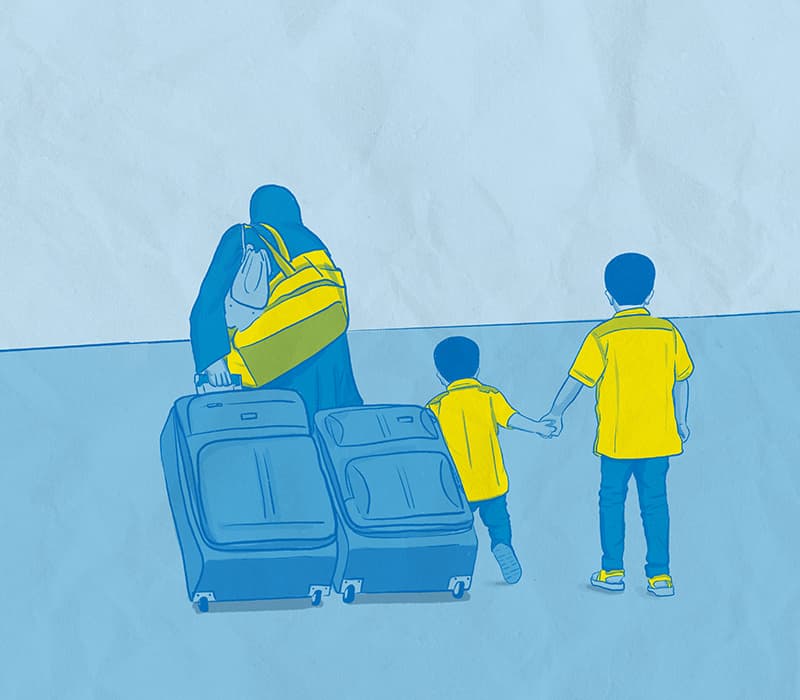Interviews with — and stories about — refugees or asylum-seekers
The way we frame stories and present images and language when reporting on refugee and asylum issues holds immense power to shape public perception. Inaccurate reporting can pose significant risks to the safety and well-being of asylum-seekers and refugees, as well as their asylum claims. This can also have far-reaching implications for their loved ones back in their countries of origin.
Framing the story
Reporting on asylum-seekers and refugees is a sensitive exercise. The choice of words, images and statistical data is not always obvious. Revealing their personal history can put a claimant at risk and influence public understanding and reaction.
At each stage of the refugee claim process, any information shared with the media can be used in the refugee determination process. People are often unaware of this fact and should therefore be made aware before a story is published.

There is no typical refugee
Perceptions of the journalist’s role
Media coverage
For these same reasons and given that each media outlet has its own procedures concerning the anonymization of persons interviewed, an editorial discussion weighing these factors should always take place when sharing information related to the identity of refugees. Such a discussion helps mitigate the potential risks of retaliation for refugees and loved ones still in their home countries.
Steps for an effective and ethical interview
Refugees and asylum-seekers are under no obligation to share their experiences with the media. Their participation is therefore entirely voluntary. Consequently, interviewees may withdraw their consent at any time before, during and after the interview until the story is published.
This means that journalists must ensure that informed consent is given at each step. A good practice to avoid a withdrawal of consent is to contact the claimant’s counsel in advance to ensure that publication of the interview will not cause prejudice to their claim.
To ensure informed consent, the interviewee must be notified that the story could potentially be translated into several languages and shared internationally, via social media networks, including in the refugee’s country of origin. This may be a determining factor in the refugee’s consent as it may potentially affect their safety and that of their loved ones in their country of origin.
- Provide breaks when the interview touches on these traumatic moments
- Do not insist on details of the violence suffered
- Respect the interviewee’s privacy
- Ensure that the person has access to psychological support or provide contact information for a social worker or psychologist in their area if the need surfaces during the interview
This list is non-exhaustive and provided for illustrative purposes only: not all people experience trauma the same way, and some are better able to cope with their emotions when talking about it.
- Conduct an advance interview to get a clear idea of the events to be recounted to prepare for them
- Ensure that listening to the account of violence does not involve a risk of (re)traumatization
In cases where an interpreter is used:
- Ensure that the interpreter is comfortable translating this type of story. Sometimes, interpreters come from the same cultural community as the person interviewed and certain taboos may exist regarding gender-based violence or refugees persecuted on the basis of their sexual orientation, or whose gender identity or expression (SOGIE) is not socially accepted
- In cases of gender-based violence or persons persecuted on the basis of their SOGIE, ask if the interviewee has a preference concerning the interpreter’s gender (note that this person may also have a preference for the journalist’s gender)
The images we use can shape public perception and understanding of these communities, which can have a significant impact on their lives. It’s essential to ensure that the visual material we choose accurately reflects the experiences of refugees and asylum-seekers, respects their dignity, and avoids perpetuating harmful stereotypes.
For example, while a story may focus on the human right to asylum, advocating for rights-based approaches, if the featured photo or video footage accompanying it only depicts interactions of asylum-seekers with police officers, it may reinforce attitudes that associate asylum with unlawful activity.
Make sure captions are accurate and avoid unethical manipulation of photos, for example, cropping out significant areas.
Take care when publishing images that may identify vulnerable individuals, especially children. The security of people fleeing persecution, and serious domestic, gender-based and gang violence may be endangered if their whereabouts are revealed.
If in doubt about the use of images, talk to the people being portrayed, making sure you have obtained their permission for the use of the image or footage in digital products or television.
When photographing or filming refugees and asylum-seekers, it’s important to ask for their permission first. This is called seeking proper consent. Informed consent means that the person being photographed fully understands what the photo will be used for and agrees to have their picture taken.
Refugees and asylum seekers may have already experienced trauma and difficult situations in their lives, and having their picture taken without their permission can make them feel uncomfortable, violated, or even re-traumatized. Seeking proper consent respects their dignity and gives them control over their own image.
Simply asking someone if it’s okay to take their photo or use their name is not enough. It’s important to ensure the individual is competent and understands what they are consenting to (for example, making sure consent is asked and provided in plain language, preferably in the individual’s native language). It must also be clear the individual is making the consent voluntarily and with sufficient information to take a decision (for example, they know what their information will be used for, how it could affect their asylum processes, understanding that there will be no repercussions to them for saying no).
Asylum-seekers and refugees are entitled to have their privacy respected.